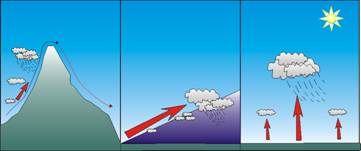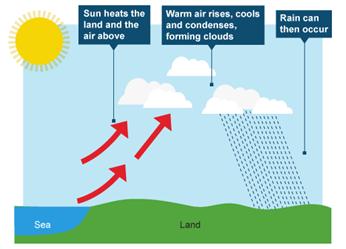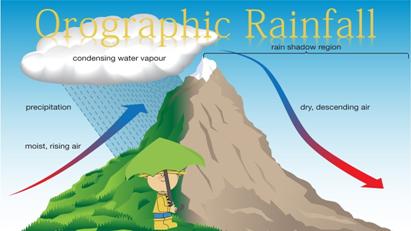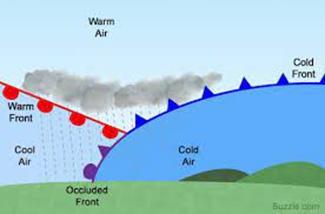




Three types of rainfall are:
This type of rainfall occurs due to thermal convention due to heating of the ground surface.
When the land warms up, it heats the air above it.
This causes the air to expand and rise. As the air rises it cools and condenses. If this process continues then rain will fall.
The following precondition must exist for this type of rainfall to occur
Abundant supply of moisture through evaporation to air so that relative humidity becomes high
Intense heating of the ground surface through incoming shortwave electromagnetic solar radiation.
Convectional rainfall occur for very short duration but occur in form of heavy showers. It makes cumulonimbus clouds.

This is a type of rainfall that occurs when air has blown over the sea and is then being forced up over an area of high land. This causes air to cool and moisture in the air to condense into rainfall
The precondition for formation of orographic rainfall are
There should be a mountain barrier across the wind direction, so that the moist air is forced on obstruction to move upward
There should be sufficient moisture in the air
The mountain must be high enough to block the incoming moist air
Once over the top of the mountain the air will usually drop down the other side, warming as it does so.
This means it has a greater ability to carry water moisture and so there is little rain on the far side of the mountain. This area is called the rain shadow.

This is a type of rainfall which occur when warmer air is forced to rise over cold air. The moist warm air condenses as it cool which causes cloud and rain. Frontal rain produces a variety of clouds, which bring moderate to heavy rainfall.

Relief features such as mountains and hills result in the rising and cooling of moist wind to for relief rainfall
windward slopes which are on the path of rain bearing winds receive heavier rainfall than leeward slopes which face away
areas near forest and large water bodies experience high rainfall and more often due to high rate of evaporation
high-pressure areas receive low rainfall than low-pressure areas due to pushing of airmasses from high pressure to low pressure. the high-pressure areas have descending dry air
when warm and cold airmasses meet frontal rainfall is formed

it influence rainfall whereby coasts washed by warm currents experience heavy rainfall when moist onshore winds are warmed by the current and made to hold on to the moisture which they release on reaching the land.
The coast washed by cold ocean currents on the other hand experience low rainfall as the result of moist wind being cooled and moisture in them condensed resulting in rain falling over the ocean thereby bringing little or no rainfall to the coastal areas. This is the cause of western margins deserts for example Kalahari and Namib desert.
In June – July when the sun is overhead in the north, intense heating occurs creating a low-pressure belt and the convergence of moist winds which result into heavy rainfall in the north.
The same condition is experienced in the south in December – January. The north and south, therefore, experience a single rainfall maximum due to the movement of the sun.
Because the sun is overhead at the equator twice a year, a double rainfall maxima is experienced in the equatorial areas such as around the Lake Victoria basin
They have a rainfall effect on the areas over which they blow because they transfer weather characteristics to the areas where they move.
The Southeast trade winds emerge from the Indian ocean when they are moist so they are responsible for the heavy rainfall experienced along the E.African coast as well as the northern shores of lake Victoria while the Northeast trade winds from the Arabian desert are responsible for the low and unreliable rainfall in Northeastern Uganda and Northwestern Kenya.
Areas located at or near the equator experience heavy rainfall which is evenly distributed throughout the year with a double rainfall maxima in March and September because the sun is overhead at the equator twice a year while areas far away from the equator experience moderate to low rainfall with a single rainfall maximum because the sun is overhead at the tropic of cancer in the north and tropic of Capricorn in the south once in a year
According to Ferrel’s law, the Southeast trade winds are deflected to the right of their path as they cross the equator due to the rotation of the earth.
This is responsible for the heavy rainfall received around the northern and north eastern shores of Lake Victoria while low and unreliable rainfall experienced in the Ankole Masaka corridor
It refers to the development of low-pressure belts over the Indian ocean due to intense insolation.
These forces winds from the interior of E.Africa to blow offshore (seaward) resulting in heavy rainfall over the Indian ocean and dry conditions in Northeastern Kenya
The Northeast and Southwest alignment of the coast forces winds to blow parallel to the coast instead of blowing onshore.
This is responsible for the low rainfall received in Northeastern Kenya.
Human activities such as deforestation, overgrazing, the sinking of boreholes, and swamp reclamation among others reduce the rate of evaporation and evapo-transpiration resulting in low rainfall.
On the other hand, afforestation and re-afforestation result in an increase in the rate of evaporation and evapotranspiration hence increasing the amount of rainfall in the areas where the trees are planted
© 2024 iasgyan. All right reserved